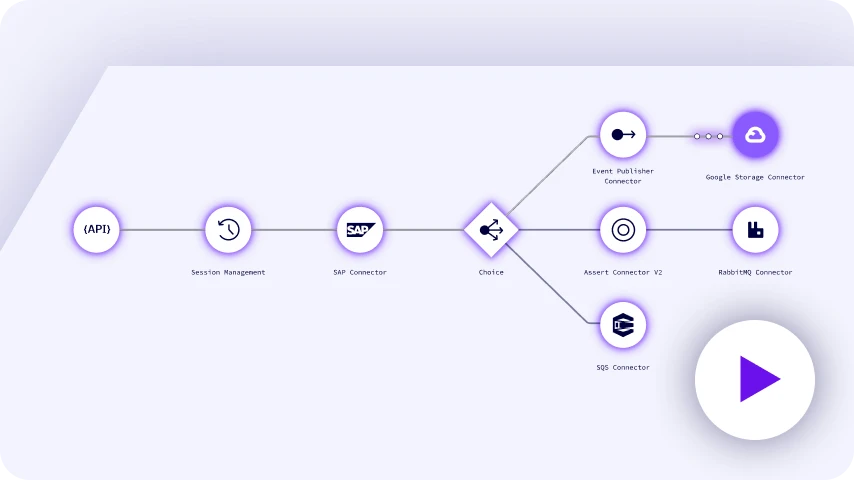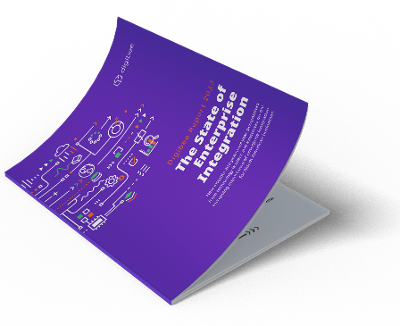
Uma análise do iPaaS empresarial da Digibee, demonstrando como ajudamos as organizações a resolver desafios complexos de integração em sistemas críticos de maneira rápida e econômica.

Uma análise do iPaaS empresarial da Digibee, demonstrando como ajudamos as organizações a resolver desafios complexos de integração em sistemas críticos de maneira rápida e econômica.

Assista como nos conectarmos de qualquer fonte, com qualquer componente, a qualquer ponto final enquanto construímos um pipeline passo a passo na plataforma de Digibee.

Aprenda a implantar pipelines em cinco cliques para testar ou ambientes de produção no ambiente de execução da plataforma da Digibee.

A integração é um primeiro passo crítico no processo de transformação digital. Para organizações dependentes de infraestrutura legada e dados isolados, não é mais algo “bom de se ter” – é uma necessidade fundamental. Mas quem realmente é responsável pela gestão da integração empresarial? Quem são os principais stakeholders da integração?

Os profissionais de desenvolvimento empresarial de hoje enfrentam desafios novos e maiores do que seus predecessores. A demanda por projetos de transformação digital está disparando à medida que as organizações buscam manter uma vantagem competitiva em um mercado global e digital-first. Ao mesmo tempo, os orçamentos estão sendo reduzidos, e desenvolvedores qualificados e arquitetos de sistemas estão em falta.
A arquitetura de integração empresarial está sendo empurrada para o final da lista crescente de projetos de tecnologia que as equipes de TI enfrentam. As equipes de desenvolvimento estão sentindo a pressão enquanto equilibram a manutenção regular dos sistemas com novas tarefas e inovações, frequentemente com uma equipe reduzida. E, não importa o quanto trabalhem, muitas vezes são vistas por outros departamentos como um obstáculo ao progresso, em vez de facilitadores do negócio.
Mas é por isso que a integração é importante. Estratégias e soluções legadas simplesmente não conseguem lidar com os problemas empresariais de hoje. Então, como os desenvolvedores e arquitetos de sistemas estão lidando com esses desafios? Qual o papel deles na estratégia de integração empresarial e o que isso significará para seus departamentos?
>> Agende uma demonstração personalizada com nossa equipe de especialistas e veja como o iPaaS da Digibee trará eficiência para o seu negócio.
A integração empresarial pode ser um divisor de águas para as empresas – mas não é uma tarefa simples. Onde recai a responsabilidade de lidar com os desafios da integração?
Curiosamente, 50% das empresas esperam contar com as equipes internas de desenvolvimento para implementar sua estratégia de integração, mas há uma desconexão sobre quem será o principal responsável. De modo geral, a maioria dos profissionais de TI empresarial está relativamente dividida sobre se a responsabilidade final cabe à equipe de desenvolvimento ou à alta direção. Mas, quando investigamos mais a fundo, encontramos disparidades nas respostas desses dois grupos:
Determinar as melhores práticas de integração e enfrentar os desafios da implementação pode não ser fácil se os stakeholders internos não concordarem sobre quem desempenha o papel chave.
A implementação bem-sucedida da arquitetura de integração empresarial ainda escapa à maioria das grandes organizações. A maioria das equipes de desenvolvimento empresarial ainda está trabalhando sem os benefícios que a integração pode oferecer – um problema que só piorará à medida que as escassezes de pessoal aumentarem e a urgência de executar a estratégia de transformação digital crescer.
71%
planejando ativamente adotar novas tecnologias de integração em 2023
79%
relatam que o tempo de inatividade do sistema foi significativo,
impactante e maior do que o esperado
75%
rely on integration to resolve IT backlog projects
59%
reported spending up to one quarter
of their IT budget on integration
*Os dados nesta tabela, originalmente publicados em outubro de 2022, foram atualizados para refletir dados do Relatório do Estado da Integração Empresarial 2023 publicado em abril de 2023.
O mais preocupante ainda é que, em 2022, a maioria das empresas que ainda não implementaram uma solução de integração (94%) nem sequer estão considerando uma solução específica de integração empresarial.
Apesar dos números baixos de execução, 57% das organizações afirmam que a integração é crítica para a estratégia de negócios, e 93% reconhecem que sua organização se beneficiaria dela. Mas por quê?
Sem uma estratégia de integração definida, muitas equipes de TI foram forçadas a recorrer a soluções de curto prazo para problemas imediatos à custa de soluções de desenvolvimento a longo prazo. Essa tática aumentou a quantidade de tempo que os desenvolvedores passam na manutenção e resposta a crises, em vez de construir para o futuro. 98% das organizações tiveram que reconstruir integrações críticas para os negócios no último ano.
Número de aplicativos principais em operação
35%: 1-3
49%: 4-6
10%: 7-9
Número de integrações reconstruídas nos últimos 12 meses
50%: 1-5
48%: 6-10
1%: Mais de 10
Vários aspectos das operações e do crescimento empresarial podem sofrer quando a integração empresarial está ausente ou mal implementada. A falta de integração pode
Os primeiros e últimos problemas dessa lista – prejudicar a inovação e desperdiçar recursos – podem prender os desenvolvedores e arquitetos de sistemas empresariais em um ciclo contínuo. A incapacidade de adotar novas soluções tecnológicas os deixa presos à manutenção e solução de problemas dos sistemas legados. Em um momento em que desenvolvedores qualificados estão em escassez, esse desperdício de recursos limita a capacidade da empresa de adotar novas tecnologias para apoiar a inovação.
Os desenvolvedores e arquitetos de sistemas querem ser os heróis operacionais que ajudam sua organização a alcançar e superar as metas empresariais, e não uma equipe subestimada que outros departamentos só lembram quando algo dá errado. A arquitetura de integração empresarial pode ajudar os departamentos de TI a eliminar silos de dados, remover bloqueios à inovação e demonstrar seu valor para o negócio.
Mas o alinhamento de todos os stakeholders e uma compreensão clara das melhores práticas, do que funciona e do que não funciona são fundamentais para aproveitar os benefícios e superar os desafios da integração.
O segundo relatório anual do Estado da Integração Empresarial da Digibee pode ajudar. Conversamos com mais de 1.000 CIOs, desenvolvedores web e arquitetos de sistemas de empresas dos EUA para entender profundamente os desafios que enfrentam e as táticas que estão utilizando. O relatório oferece uma visão abrangente e baseada em dados sobre tendências atuais e futuras, além de orientações sobre as melhores práticas de integração.


Logo após começarmos nossa conversa, percebi que Thais é uma pessoa voltada para as pessoas, então não foi surpresa descobrir que ela encontrou sua vocação trabalhando em recursos humanos. Eu poderia ter conversado com ela o resto do dia sobre seu papel e o impacto significativo que ele tem na cultura da Digibee, mas ambos somos (Digi)abelhas ocupadas e precisávamos voltar ao trabalho empolgante.


Como líder de negócios, você é responsável pela saúde e sucesso da empresa. Responsável perante o conselho, investidores, clientes e funcionários, você deve garantir que a organização responda com agilidade às mudanças no mercado.

O trem da migração para SAP S/4HANA ainda está na estação, e — graças ao feedback da indústria — ele veio para ficar. Pelo menos até 2027, quando o suporte para SAP ECC terminar. No entanto, esse descanso bem-vindo é apenas uma pausa no que, para muitas empresas, será a maior atualização de infraestrutura em décadas.
Para algumas organizações, o SAP S/4HANA pode ser a primeira incursão séria na nuvem e um passo importante na sua evolução digital contínua. Com a agilidade da nuvem e processos verdadeiramente digitalizados para alimentá-los, essas empresas agora podem apoiar novas e inovadoras formas de fazer negócios.
Embora seja certo que a mudança do SAP ECC para o SAP S/4HANA exigirá investimentos significativos em tempo e recursos, um dos maiores impactos nas empresas é a dívida técnica acumulada ao longo dos anos (e até décadas) de uso da arquitetura SAP ECC.
| 1992 | O primeiro ERP da SAP foi construído com base no software SAP R/3 com várias aplicações em cima do SAP Basis (um conjunto de programas e ferramentas middleware). Todas as aplicações foram construídas sobre o SAP Web Application Server, com conjuntos de extensões usados para entregar novas funcionalidades e estabilizar o núcleo. |
| 2004 | Ocorreu uma mudança completa na arquitetura com a introdução do mySAP ERP com o ERP Central Component (SAP ECC), substituindo o R/3 Enterprise. |
| 2006 | A versão mais recente (SAP ERP 6.0) foi lançada, com atualizações subsequentes usando os pacotes de melhoria da SAP. A mais recente foi o pacote de melhoria SAP 8 para SAP ERP 6.0 (lançado em 2016). |
| 2015 | O SAP S/4HANA foi lançado. |
| 2027 | O suporte para SAP ECC terminará. |
Com base na linha do tempo do SAP ERP, é provável que haja clientes SAP que estão usando o software há quase 20 anos. Durante esse tempo, uma quantidade incalculável de codificação personalizada foi realizada para alinhar melhor as capacidades do SAP pronto para uso com os requisitos específicos do negócio. Infelizmente, a codificação personalizada tem um custo.
>> Agende uma demonstração personalizada com nossa equipe de especialistas e veja como o iPaaS da Digibee trará eficiência para o seu negócio.
A necessidade de codificação personalizada é atribuída ao modelo rígido imposto pelas ferramentas da SAP, que exigem trabalho adicional de desenvolvimento (e manutenção subsequente) para adaptar a tecnologia aos processos do negócio.
“Código personalizado é a maior barreira para migrar ou atualizar para um novo ambiente SAP.”
80% das organizações pesquisadas
Pillir ASUG Report, 2021
Isso é confirmado pelos números: 91% dos usuários SAP dependem de código personalizado, com 90% do código em uso sendo considerado “importante” a “extremamente crítico”. Na verdade, 80% das organizações consideram o código personalizado SAP sua maior barreira na migração ou atualização para um novo ambiente SAP.
Essas personalizações estão entrelaçadas por toda a empresa, facilitando funções importantes, como CRM, sistemas de pedidos, gerenciamento de inventário, faturamento, contabilidade e muitos outros processos críticos para os negócios. Além disso, quase metade das aplicações em questão foram desenvolvidas há mais de seis anos, o que significa que esses sistemas e a lógica de negócios associada já não são contemporâneos.
Além disso, existem os recursos necessários para manter esse modelo. Em particular, a dependência dos mesmos especialistas que construíram as personalizações para gerenciar quaisquer transições toda vez que uma nova ou diferente plataforma é ativada no ambiente existente. Esse isolamento de expertise complica os esforços para inovar, especialmente quando esses especialistas deixam a empresa.
| Os números – $800K gasto anual (média) nas aplicações personalizadas mais importantes (2-3) – Mais de 1000 aplicações personalizadas para um cliente típico – 20-30 instâncias SAP em funcionamento ao mesmo tempo para algumas empresas da Fortune 500 |
Essa grande dívida técnica precisa ser reconciliada. Não apenas ela afeta as margens de lucro, como também atrasa a implementação de tecnologias modernas, que são críticas para a capacidade da empresa de competir e ter sucesso no mercado.
O código personalizado é normalmente utilizado para conectar dois sistemas (também conhecido como integração ponto a ponto personalizada). Mas o que começa como um exercício relativamente simples de “conectar o ponto A ao ponto B” rapidamente se transforma em uma bagunça confusa com conexões sobrepostas que são difíceis de manter e impossíveis de escalar.
A migração para SAP S/4HANA é um ponto de partida perfeito para empresas sobrecarregadas pela arquitetura semelhante a espaguete resultante do código personalizado SAP. Em vez disso, as organizações podem aproveitar a tecnologia de plataforma de integração como serviço (iPaaS). Esse modelo usa integrações de API que conectam de forma transparente os sistemas atuais e a nova plataforma SAP S/4HANA.

A Bauducco migrou de seu sistema ERP legada para o SAP S/4HANA, integrando 14 sistemas com a nova plataforma e eliminando a necessidade de trabalhos de personalização dispendiosos. Saiba mais →
Embora a migração de dados seja um passo crítico na transição de SAP ECC para SAP S/4HANA, ao aproveitar a tecnologia iPaaS, os clientes SAP não precisam mais acomodar o código personalizado que foi criado ao longo dos anos, eliminando essencialmente sua dívida técnica enquanto acelera a estratégia de migração para a nuvem SAP.
A Digibee ajuda as empresas a evoluir de integrações personalizadas para integrações simplificadas. Nossa tecnologia iPaaS preenche a lacuna entre sistemas atuais e novas tecnologias, conectando dados e plataformas que nunca foram conectados antes, independentemente dos silos ou infraestrutura legada subjacente.
Em vez de ver a extensão do fim de vida do SAP ECC até 2027 como um alívio, os clientes da Digibee estão acelerando seus cronogramas de migração para eliminar mais rapidamente a acumulação contínua de dívida técnica. Com gastos em codificação personalizada alcançando (e muitas vezes superando) $1M anualmente, quanto mais rápida for a migração para o SAP S/4HANA, mais cedo eles poderão reconciliar a dívida técnica que acumularam (e que continua crescendo).
Com o modelo de integração de baixo código da Digibee, nossos clientes implementam integrações 40% mais rápido, reduzindo os custos operacionais com menos incidentes, tempos de recuperação mais rápidos e sem tempo de inatividade. Essas eficiências ajudam a liberar recursos para se concentrar no trabalho de migração mais prioritário para o SAP S/4HANA.
Agende uma demonstração conosco para saber mais.

A metodologia Digibee permite integrações entre sistemas, concentrando -se nos dados em si, e não nos componentes e conexões.
sobre este white paper
Integração de sistemas e a exposição de APIs são processos complexos que dependem de equipes técnicas e ferramentas de TI para conectar sistemas locais e/ou nuvem, exigindo conhecimentos, habilidades e um alto nível de segurança.
Digibee reduz drasticamente a complexidade, permitindo integrações entre os sistemas, concentrando -se nos próprios dados, e não nos componentes e conexões. A metodologia Digibee criou garante que as empresas tenham conhecimento e controle sobre seus dados de uma maneira ágil, simples e eficiente, mantendo o foco na arquitetura à prova de futuro.
Entenda os desafios de transformação digital que as organizações estão enfrentando e o papel da integração:
Os benefícios do iPAAS de Digibee
Digibee permite reduzir a complexidade das integrações, para que você possa se concentrar em seus principais valores e estratégias, alavancando benefícios como:
Download Digibee e o contexto de mercado e aprenda mais sobre como nosso modelo e abordagem inovadores para integrações se concentram nos fluxos de dados, em vez de componentes e conexões, alavancando o poder da sua organização para um gerenciamento de dados mais eficaz.

Nossa moderna plataforma de integração empresarial cria integrações com velocidade, custos mais baixos e entrega valor comercial com mais rapidez.

Eu conversei com o Head of Product Management e baixista de primeira linha (minhas palavras, não as dele) Rodrigo Lara, para uma discussão envolvente sobre o presente e o futuro da Digibee do ponto de vista de um dos seus primeiros funcionários.

Visualização que resume o valor do nosso eiPaaS do relatório Total Economic Impact™ da Digibee’s Integration Platform as a Service (eiPaaS) da Forrester.
X